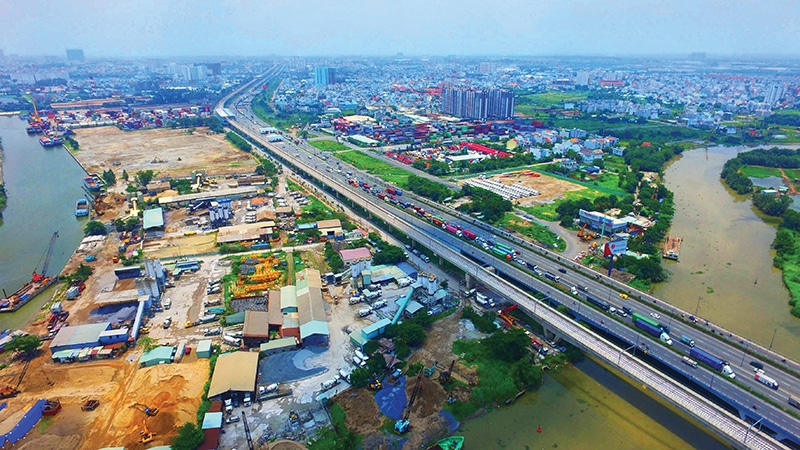Raft of developments far behind schedule
 |
| Thu Duc City is planned to develop into Ho Chi Minh City’s new creative urban and financial hub, photo Le Toan |
Tran Quang Lam, director of Ho Chi Minh City Department of Transport, said that the future Thu Duc City would demand about VND300 trillion ($13 billion) to upgrade transport infrastructure. Of this, roads are forecast to occupy about VND135 trillion ($5.87 billion), railways and buses will need more than VND140 trillion ($6.08 billion), and waterways will require about VND24 trillion ($1.04 billion).
In the 2021-2030 period, four big projects for the city will be carried out, including Ring Road No.2 from Phu Huu Bridge to Pham Van Dong street, and An Phu intersection. Moreover, some public-private partnership schemes related to the city will be soon carried out such as the Ho Chi Minh City-Thu Dau Mot-Chon Thanh superhighway, Ring Road No.3, and National Highway No.13.
Nevertheless, many of these same ventures are already behind schedule. Even National Highway No.13, which initially had an extension approved exactly 20 years ago, has seen no actual expansion work carried out since. Ring roads are also in the quagmire. The area in question consists of three ring roads at a total proposed length of 356km. Of this, Ring Road No.2 is responsible for traffic divergence, and ring roads 3 and 4 take obligation for area links.
However, to date, Ring Road No.2 has been put into operation with only 55km, while 14km are currently under construction. Ring Road No.3 has only seen 16km of its proposed 90km being completed, and Ring Road No.4 is still under preparation.
A representative of Ho Chi Minh City Department of Transport said that the first and the second phases of Ring Road No.2 have yet to be approved in terms of investment direction.
Infrastructure congestion in Thu Duc also occurs – particularly, the relocation of the Truong Tho Port complex is causing part of the inadequacy. In rush hours, the area is submerged in traffic jams with thousands of vehicles circulating daily, according to data provided by the Department of Transport.
“To resolve the breakdown, Ho Chi Minh City People’s Committee has directed relocation of the port but the timeline to carry it out extends into 2022 because it depends on the investment progress of Long Binh Port,” said Bui Hoa An, deputy director at the department.
With prominent advantages in position and development policies, a raft of major real estate developers like Vingroup, Novaland, Dai Quang Minh, Hung Thinh, and Tien Phuoc have flocked to the eastern part of Ho Chi Minh City for project deployment.
Along with this, projects have sprung up along National Highway No.13 in the southern province of Binh Duong like Opal Skyline and Opal Central Park.
Meanwhile the prices of housing projects in the east of Ho Chi Minh City fetches from VND40-180 million ($1,750-$7,800) per square metre, while that of land plot projects ranges from VND40-200 million ($1,750-$8,700) per sq.m. Completed houses cost at least VND9 billion ($391,300) per unit, even skyrocketing to VND100 billion ($4.34 million) per villa.
In Binh Duong, some projects now in the development pipeline in Thuan An city are expected to witness 40-60 per cent price jump compared to a year ago. Most projects along National Highway No.13 have prices hovering around VND30-45 million ($1,300-$2,000) per sq.m and could increase further once the project on upgrading the highway gets underway.
According to Ngo Quang Phuc, CEO of Phu Dong Group, National Highway No.13’s expansion not only helps boost real estate prices, but is also fuelling economic exchanges between Ho Chi Minh City and Binh Duong. “Once travel between both locations is facilitated, more people would move to the city’s satellite areas, helping to heat up the real estate market there,” Phuc insisted.
For the future, Thu Duc City to meet the expectations of both Ho Chi Minh City’s leaders and people, architect and planning expert Ngo Viet Nam Son stressed the importance of strong planning work for the area. “Sustainable development and environmental factors must be put at top priority to stop traffic overload or flooding. Only then will people find Thu Duc to be a truly liveable city,” Son said.
Son also underlined the need to have in place regional connectivity not only with areas in the proposed new Thu Duc City, but also with other neighbourhoods. “Thu Duc City shall be the core zone linking Long Thanh International Airport in Dong Nai, Cai Mep Port in Ba Ria-Vung Tau, and Binh Duong. This will help facilitate transport significantly,” Son explained.
“Meanwhile, people can save on their living costs when they work in Ho Chi Minh City, but settle for a life in Long Thanh or Binh Duong where the housing price is much lower than that of Ho Chi Minh City.”
What the stars mean:
★ Poor ★ ★ Promising ★★★ Good ★★★★ Very good ★★★★★ Exceptional
Related Contents
Latest News
More News
- HITC ties up with Evolution to develop AI and hyperscale data centres in Vietnam (December 11, 2025 | 12:09)
- Real estate deals boom via high-profile names (December 08, 2025 | 11:32)
- Industrial segment shaped by M&As (December 08, 2025 | 08:00)
- The Privé sets the benchmark for luxury real estate (December 05, 2025 | 08:28)
- TD CASA and the rise of bespoke interior design in luxury living spaces (December 03, 2025 | 14:14)
- Lee Soo-man's Blooming Sky to build Gia Lai culture, sport, and entertainment complex (December 02, 2025 | 16:41)
- Sustainability in DNA of Keppel Vietnam's future urban development strategy (November 28, 2025 | 10:53)
- South Korean investors seek clarity on IP lease extensions (November 24, 2025 | 17:48)
- Streamlined administration boosts Vietnam's hotel investment prospects (November 21, 2025 | 19:13)
- Starlake emerges as Hanoi’s new Grade-A office hub (November 21, 2025 | 19:02)

 Tag:
Tag:





















 Mobile Version
Mobile Version